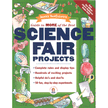 Science Fair Project Report
Science Fair Project Report
* Using your notes you can easily prepare a project report, which explains what you did.
Check with your instructor for specific directions, or get approval for using the following report outline.
Title Page
*Your project’s name (it can be in the form of a question) Your name, school and grade.
Table of Contents
*List the parts of your report (Introduction, Hypothesis and Research, Procedure/Experiment, etc) and the page numbers where they begin. You’ll have to make this page after the others.
Introduction
*One paragraph that tells the whole story. One way to do this is to write a sentence for each idea in the scientific method. One for the purpose, one telling what experiment or test you did, etc.
Hypothesis and Background Research
*State your PURPOSE in more detail, what made you think of this project. Tell what you found out from the books or other sources you used to learn about your topic and be sure those sources are listed in your bibliography.
Procedure/Experiment
*List the materials you used and what you did. If drawings will make it clearer, draw on separate pages and put in this section. Explain in detail things you made.
Results
*Describe what happened, what you observed. Show your data, which can include diagrams.
Conclusion
*Describe your interpretation of your results. Look over your notes, charts, and log and write what you think your data shows. You can put your opinions here. Was your hypothesis (what you expected to happen) correct? Don’t be afraid to say that you might have made a mistake somewhere. Great discoveries can come from what we learn from mistakes!
Be sure to state the limitations of your project. (For example, if your project was to find out something about dogs and you used your dog, you can say “My dog did this. This might not be the same for other dogs.” You can’t say that all dogs would behave the same as yours because you didn’t check all dogs.)
Credits/References
*List of books, articles, pamphlets, people you talked to and any other sources you used for researching your idea and writing your paper. Sources
They are written or typed in this form:
Last name of author (or person you talked to), First name, “Title of article or chapter”, Title of source (book title , magazine title or “Conversation”), Place where published:Publisher name, Date, volume: pages.
Examples:
Jones, Thomas A., “The Development of the Chick” Animal Development Magazine,
June 1976, Vol. 16:27-34.
Peracchio, Laura, Telephone Conversation, Feb. 15, 1993.
Send comments and suggestions to ASK JANICE
RETURN TO SCIENCE FAIR PROJECT TEACHING TIPS for the next step
 |
Janice VanCleave’s Guide to More of the Best Science Fair Projects |